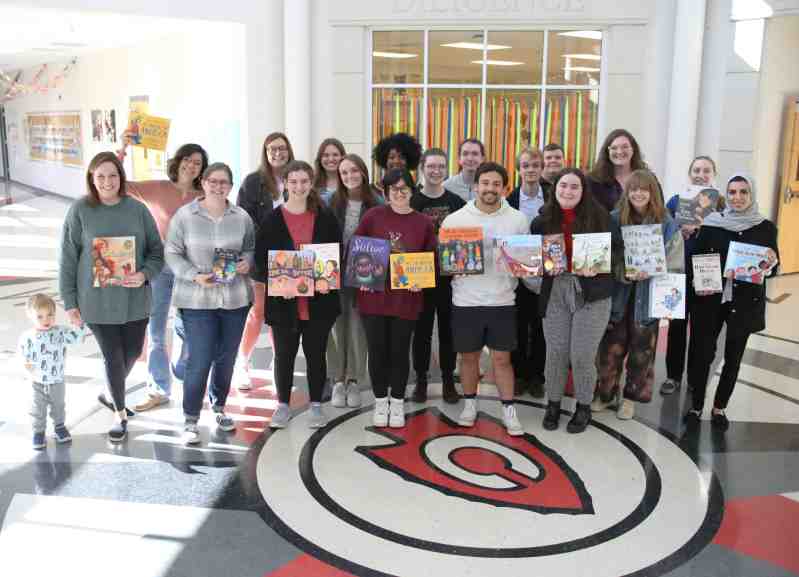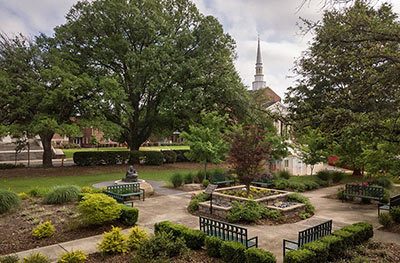MC Students’ Cultural Awareness Center Helps Bridge Language Gap at Eastside Elementary School

According to the latest U.S. News and World Report educational survey, more than 5 percent of students in the Clinton Public School District are English language learners. The district itself touts that 21 languages other than English are represented, including Spanish, Vietnamese, and Arabic.
Those statistics comprise a significant number of children who are accustomed to speaking a language other than English in their homes and must navigate an educational environment traditionally geared toward English-language speakers. Not only is their situation linguistically challenging, but in many instances, they must adapt to an educational system that is deeply rooted in a culture quite different from their own.
While Clinton schools provide an English Language Learner program and other resources for teachers who must help bridge the communication and cultural gaps among some of their pupils, additional resources are needed as the district – and the surrounding community – continues to welcome an increasingly global population.
In this educational climate, Ashley Krason saw an opportunity for her service-learning students at Mississippi College. The assistant professor in the Modern Language Department and coordinator of the Teaching English to Speakers of Other Languages Program and the Academic Foundations Program at MC led an effort by her MLG 450 class to establish a Cultural Awareness Center at Eastside Elementary School.
“It’s tricky when you’re developing a service-learning project because students must learn the course objectives and put them in practice, but it’s not true service if you’re not meeting a need expressed by your community partner, which, in our case, is Eastside Elementary School,” Krason said. “Because of the pandemic, our students were unable to go into the schools where the children are. It took us a while to determine a need we could meet without actually interacting with the elementary students.”
She said the idea for the Cultural Awareness Center came about while speaking with Rebecca Brill, the English learning instructor at Eastside, who had been serving as a de facto resource for other teachers at her school who were trying to help students from other cultures become more comfortable in their classrooms.
“We wanted to create a resource center where these mainstream teachers could come and get resources whenever it would be helpful to them,” Krason said.
The center provided more than 50 picture and chapter books that focus on diverse characters’ experiences and include various cultural elements seldom found in stories written for native English speakers. It also included four bilingual picture dictionaries in Spanish, Arabic, Hindi, and English, to help youngsters learn to communicate more easily with their teachers and peers.
In partnership with the Communication Department at MC, Krason’s students made audio and video recordings of the books, many of which are bilingual. They labeled each hard copy book with Accelerated Reader points and QR codes that link young readers to supplemental activities and pertinent cultural online resources. They decorated a bookshelf at Eastside Elementary to serve as the official resource center. And they raised all the funds necessary – almost $600 – to complete the project on their own.
“There is often a lack of multicultural, diverse, multilingual books in our public schools, and research indicates how valuable these resources are for students of color, English-learning students, and immigrant families,” Krason said. “We were very careful to add books that any student can read, including multiple chapter books that had characters from other cultures as protagonists. It’s important to represent heroes in all cultures.
“These books are for everyone, not just foreign-language students. Students can borrow the books, or teachers can read them aloud to their classes.”
The MC students who were recorded reading the books took great care with pronunciations. One student preparing to read a book containing several Korean names took a significant amount of time practicing how to say them correctly so they would be represented as accurately as possible.
The grand opening for the Cultural Resource Center at Eastside Elementary took place on Feb. 28 – just in time to kick off the National Education Association’s Read Across America Week. Although Krason and her students were unable to attend the event in person, they had the opportunity to discover the impact the Cultural Awareness Center has already made on the youngsters.
“Ms. Brill sent me photos and video of her students looking through the books,” Krason said. “Service-learning is an experiential style of teaching that requires reflection, so I was excited to show my students the smiles and the reactions from the children. I just wish they could have seen that in person.”
The reaction from one Eastside Elementary student was particularly meaningful. As a native Spanish speaker, the young scholar said it was difficult to find books in that language, let alone books that included characters that looked like or told stories relevant to the student.
“Just having a book that included a character that called her grandmother ‘Abuela’ was a big deal – even in an English language picture book,” Krason said. “That firsthand experience was touching for everyone.”
That included Jheslia Vidal-Alonso, a junior linguistics major and missions minor from Vicksburg. Born in Mexico, Vidal-Alonso and her family moved to Mississippi a little more than a decade ago. She hopes to one day teach either English or Spanish as a second language in the mission field, in the U.S. or abroad.
“I don’t think that many people have noticed that we are living in one of the most cross-cultural times our world has ever seen, and the statistics say that the world where my kids will live in one day will be even more so,” Vidal-Alonso said. “There are many reasons why we should be concerned with understanding other cultures – technological, global, economic, geographic, and more – but the one that is rooted in my heart is the Christian imperative.
“Since I was growing up, I heard in church that man was created in the image of God. My thought was, ‘OK, that’s cool,’ but what really changed my mind was to know that when I close myself to knowing other people’s culture, language, and the person itself, I’m closing myself to knowing the image of God that was placed in every human being.”
She said her heart goes out to children from other countries who didn’t have a choice of where they would grow up.
“Suddenly, they are now in a place where they don’t know the language or the culture,” she said. “That stage is hard, and I can speak from that experience. So, seeing that schools are welcoming these students and even providing resources or materials in their heart language for them and for other students who want to learn more about other countries can make a great difference in their lives.”
Her hope for the Cultural Awareness Center is for students from other cultures to gain confidence that it’s perfectly okay to come from another country or to speak a language other than English.
“Most of them decide to conform themselves to the culture that surrounds them, while at the same time carrying their own,” Vidal-Alonso said. “I guess that one of the main reasons they do this is because of the lack of interest in their culture, or because of the negative stereotypes that have been placed on them and their culture.
“This project can help not only them, but also English-speaking students. Talking about how our world is getting more and more cross-cultural, this project can help them learn about the cultures and countries around the world. I hope that we can bring this to them in such a way that it can stick with them, that they can break the status quo, and that later on in their college years, they can have a genuine desire to prepare themselves in cross-cultural studies that can help them to become better in their work field.”
David Torrent, a junior math education major from Oxford, shouldered much of the load making recordings of his classmates reading the books for the Cultural Awareness Center. He said he wanted to make sure the audios and videos were of the highest quality so the Eastside Elementary students could get the most benefit from them.
“I wanted the students to be able to see the college student that was reading the book while also being able to follow along and see the pictures and words on the page,” Torrent said.
He referenced a speech by Nigerian author Chimamanda Ngozi Adichie warning against the dangers of only telling one aspect of a country or culture.
“We have talked a lot in class about the importance of learning other cultures than your own. Being exposed to a lot of literature from other cultures, especially when you are young, can help you form a complete story and help eliminate what can eventually turn into bias, making it easier to understand and interact with people from other cultures.
“For students that do come from the culture represented in these books, it can make them feel heard and represented in a setting where they may feel like they aren’t understood. It can encourage them to feel comfortable in their skin knowing that other people somewhere in the world have experienced what they are experiencing.”
Krason’s MLG 450 class is one of four required for MC students to earn their ESL certification, an important credential for instructors who want to assist students from all parts of the world and all different backgrounds in meeting their educational objectives in English. She said watching her class members join together to complete the service-learning project was especially gratifying, considering how it will benefit students at Eastside Elementary School.
“My students see the need for culturally responsive schools and the need for minorities and non-native-speaking English people to be reflected in literature,” Krason said. “It’s important for their identity development.
“I know it’s in these teachers’ hearts to meet the needs of these students. It can be overwhelming, especially when students from multiple cultures are in the same class, or students from different cultures cycle into the class the following year. Teachers are asked to do so much, so if something like this can provide them some assistance, then I think it’s important.”
Vidal-Alonso said hearing the Eastside teachers thank the MC students for the project helped her realize she and her classmates were helping bring about welcome change into the elementary school classroom.
“I would love to see MC more involved in this and the next class that takes after us to continue this project and bring their new ideas, methods, and skills, making this project more complete.”
Torrent, an aspiring math teacher, said the project opened his eyes to the world around him.
“I have been able to see diversity in culture, not only in the books we have compiled, but also in my classmates,” he said. “We are all very different from one another, with different interests, experiences, cultures, languages, nationalities, you name it. While literature may not be as prevalent in a math classroom, the celebration of our different cultures can be, and I am excited to be able to display that in my own classroom one day.”
Krason said all of the resources used for the Cultural Awareness Center would remain at Eastside Elementary School for future teachers and students to use. Community support is welcome. For more information, email her at akrason@mc.edu or Brill, ESL instructor at Eastside and adjunct TESOL instructor at MC, at rmbrill@mc.edu.
Sign-up For Our Newsletter
Get the latest news about Mississippi College delivered right to your inbox by subscribing to the Along College Street e-newsletter.


